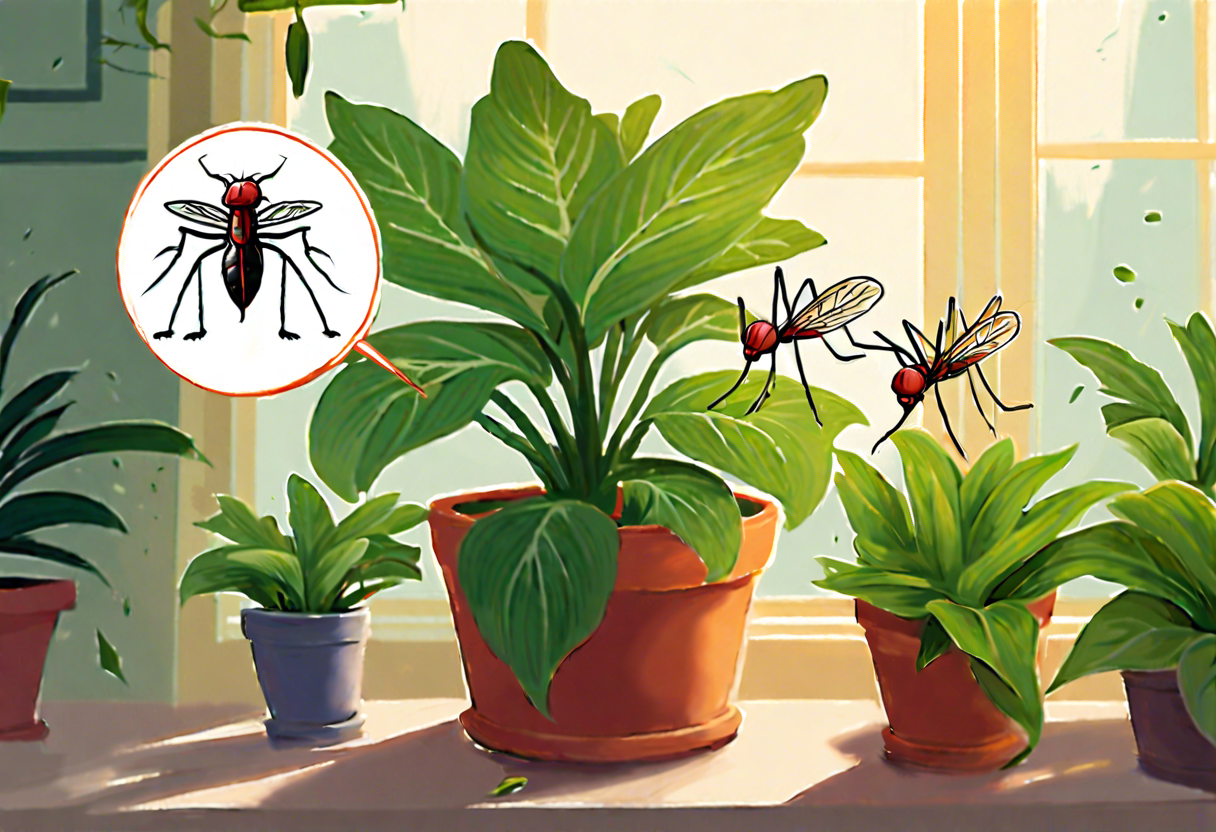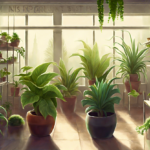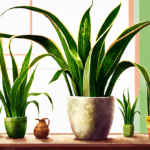Natural Remedies to Eliminate Gnats from Indoor Plants
Gnats are tiny, annoying insects that can easily infest indoor plants. These pests not only annoy us with their constant buzzing but also pose a threat to the health of our beloved plants. Luckily, there are several natural remedies that can help you get rid of gnats and keep your indoor plants thriving. Here are some effective methods you can try:
-
Sticky Traps: Place yellow sticky traps near your plants to catch adult gnats. The bright color attracts them, and once they land on the sticky surface, they can’t escape. This method is simple yet highly effective in reducing the gnat population.
-
Apple Cider Vinegar: Create a homemade gnat trap by filling a small container with apple cider vinegar and a few drops of dish soap. The scent of vinegar lures the gnats in, and when they land in the liquid, the soap breaks the surface tension, causing them to drown.
-
Neem Oil: Neem oil is a natural insecticide derived from the neem tree. It not only kills adult gnats but also disrupts their life cycle by affecting larvae and eggs. Mix a few drops of neem oil with water and spray it directly on the soil of your infested plants. This will help eliminate the gnats and prevent further infestation.
-
Sand or Grit: Gnats lay their eggs in moist soil. By adding a layer of sand or grit on top of the soil, you create a barrier that prevents them from reaching the moist environment they need to thrive. This method is particularly effective for plants that prefer drier conditions, such as succulents.
-
Cinnamon: This common kitchen spice is a natural antifungal agent and can help get rid of gnats. Sprinkle cinnamon powder on the soil surface, and its strong scent will repel the gnats. Additionally, cinnamon helps prevent fungal growth, which is often a contributing factor to gnat infestations.
-
Allow the Soil to Dry: Gnats thrive in moist conditions, so allowing the soil of your indoor plants to dry out between waterings can help reduce their population. This not only makes the environment less favorable for gnats but also encourages the roots to grow deeper, leading to healthier plants overall.
By incorporating these natural remedies into your plant care routine, you can effectively control and eliminate gnats from your indoor plants. Remember to be consistent and patient, as it may take some time to completely eradicate them. With time and persistence, you can enjoy a gnat-free environment and thriving, healthy plants.
Preventative Measures to Avoid Gnat Infestations in Indoor Plants
Gnats can quickly become a nuisance when they infest your indoor plants. These tiny flying insects are not only bothersome, but they can also cause damage to the roots of your plants. Fortunately, there are several preventative measures you can take to avoid gnat infestations and keep your indoor plants healthy and thriving.
1. Choose the Right Potting Soil
One of the key factors that attract gnats to indoor plants is moist and nutrient-rich potting soil. To prevent gnat infestations, opt for a well-draining potting soil mix that allows excess water to flow out easily. This will help to keep the soil from becoming overly saturated and reduce the likelihood of gnats laying their eggs in it.
2. Allow Soil to Dry Between Waterings
Overwatering your indoor plants is not only detrimental to their health, but it also creates an ideal environment for gnats to breed. To avoid this, allow the soil to dry out between waterings. Stick your finger about an inch deep into the soil, and if it feels dry, it’s time to water your plant. This will not only help prevent gnat infestations but also promote healthier root growth in your plants.
3. Use Yellow Sticky Traps
Yellow sticky traps are an effective tool for catching and monitoring gnats. These traps come in the form of bright yellow cards coated with a sticky substance that lures gnats towards it. Place the traps near your indoor plants, and the gnats will get stuck to the surface, reducing their population. Make sure to check and replace the traps regularly for maximum effectiveness.
4. Avoid Overfertilizing Your Plants
Excessive fertilization can lead to an increase in the number of gnats in your indoor plants. Gnats are attracted to the nutrients present in the soil, and overfertilization can create an excess of these nutrients, making it an ideal breeding ground for the insects. Follow the recommended guidelines for fertilizing your plants and avoid overdoing it to prevent gnat infestations.
5. Maintain a Clean Environment
Keeping your indoor plant area clean and free from debris is another important step in preventing gnat infestations. Regularly remove dead leaves, fallen flowers, and any decaying organic matter from the soil surface. This will eliminate potential breeding sites for gnats and discourage them from laying their eggs in your plants.
By following these preventative measures, you can greatly reduce the risk of gnat infestations in your indoor plants. Remember to choose the right potting soil, allow the soil to dry between waterings, use yellow sticky traps, avoid overfertilization, and maintain a clean environment. With these steps in place, you can enjoy your indoor plants without the annoyance of gnats buzzing around.
Identifying Types of Gnats on Indoor Plants
Gnats are small, flying insects that can become a nuisance in households, particularly around indoor plants. While all gnats may look the same to the untrained eye, there are several different types that can infest indoor plants. Identifying the specific type of gnat infestation is crucial for effectively implementing control measures. Here, we will discuss the most common types of gnats found on indoor plants and how to distinguish them.
-
Fungus Gnats:
Fungus gnats are the most common type of gnat found on indoor plants. These small, dark-colored flies measure around one-eighth of an inch in length. Fungus gnats are attracted to damp soils and are often seen flying near the plants or crawling on the soil surface. They feed on decaying organic materials and plant roots. Fungus gnats can become problematic if their population grows, as their larvae can cause damage to the roots of plants. -
Shore Flies:
Shore flies closely resemble fungus gnats in terms of appearance. However, they have a slightly larger size and longer wings. These flies are commonly found around moist or over-watered potted plants. Shore flies usually appear in large numbers and can be seen resting on plant leaves, soil, and other surfaces. Unlike fungus gnats, shore flies do not damage plant roots but can still be a nuisance. -
Fruit Flies:
While fruit flies are not specifically attracted to indoor plants, they can become a problem if fruits or vegetables are present near the plants. These tiny flies are usually brown or yellowish and are known for their rapid breeding abilities. Fruit flies are attracted to decaying organic matter, such as overripe fruits, vegetable scraps, or compost bins. To prevent fruit fly infestations, it is important to maintain cleanliness in the kitchen and discard any overripe fruits or vegetables promptly. -
Drain Flies:
Drain flies, also known as moth flies, are small, hairy insects that are commonly found in damp areas such as drains, bathrooms, and sewage systems. While they are not directly associated with indoor plants, they may occasionally be seen around potted plants if there is excessive moisture or organic debris present in the potting soil. Drain flies can be easily distinguished by their fuzzy appearance and erratic flying patterns.
By being able to identify the different types of gnats that are commonly found on indoor plants, you can take appropriate measures to control their populations effectively. Implementing preventive measures such as proper watering techniques and regular soil inspections can help keep gnat populations at bay and ensure the health of your indoor plants.
Proper Watering Techniques to Reduce Gnat Populations on Indoor Plants
One of the most common pests that indoor plant owners face are gnats. These tiny insects, commonly known as fungus gnats, can be quite a nuisance as they hover around plants and even lay their eggs in the soil. However, by incorporating proper watering techniques, you can effectively reduce gnat populations on your indoor plants. In this article, we will discuss some practical tips to help you with this issue.
1. Allow the Soil to Dry Out: Gnats thrive in moist conditions, so it’s essential to allow the soil to dry out between waterings. This helps to interrupt the gnat life cycle and discourages their reproduction. Before watering, check the moisture level of the soil by inserting your finger up to your knuckle. If the soil feels dry, it’s time to water your plants.
2. Water with Care: When watering your indoor plants, it’s crucial to do so with care. Avoid overwatering, as excess moisture can create an ideal breeding ground for gnats. Ensure that the water penetrates deep into the soil rather than just wetting the top layer. This encourages the plant roots to grow deeper, making the plants less susceptible to gnat infestations.
3. Use Bottom Watering: Another effective method to reduce gnat populations is bottom watering. Instead of pouring water directly onto the soil, place the pot in a tray or saucer filled with water. The plant will absorb the water from the bottom, helping to keep the top layer of soil dry. This method also prevents the gnats from accessing the moist surface to lay their eggs.
4. Remove Excess Water: After watering your plants, ensure there is no standing water left in the saucer or tray. Gnats are attracted to stagnant moisture, and leaving excess water can create a favorable environment for them. Empty the tray or saucer promptly to eliminate potential breeding sites.
5. Improve Drainage: Poor drainage can contribute to the retention of excessive moisture in the soil, leading to gnat problems. If you notice that your plants’ pots don’t have adequate drainage holes, consider repotting them into containers that allow for proper water drainage. This helps to prevent water from sitting at the bottom, reducing the risk of gnat infestation.
6. Maintain Cleanliness: Keeping the area around your indoor plants clean and free from fallen leaves or debris can also aid in reducing gnats. These insects can feed on decaying organic matter, so removing any potential food sources will make your plants less attractive to them.
By implementing these proper watering techniques, you can significantly decrease gnat populations on your indoor plants. Remember to monitor your plants regularly and take immediate action if you spot any signs of gnat infestation. With a little care and attention, you can enjoy beautiful, pest-free indoor plants.
The Best Insecticides for Controlling Gnats on Indoor Plants
Indoor plants are a great way to bring nature into your home and brighten up your living space. However, they can also attract unwanted pests, such as gnats. These tiny insects can be a nuisance, but thankfully, there are several effective insecticides available that can help you get rid of gnats and keep your indoor plants healthy. In this article, we will explore some of the best insecticides for controlling gnats on indoor plants.
One of the most popular insecticides for gnats is neem oil. Derived from the neem tree, neem oil is an organic and natural solution that not only kills adult gnats but also disrupts the life cycle of these pests. To use neem oil, dilute it with water according to the manufacturer’s instructions and spray it on the affected plants. Be sure to cover both the upper and lower surfaces of the leaves, as this is where gnats tend to lay their eggs. Neem oil is safe to use on most indoor plants and does not harm beneficial insects like bees and ladybugs.
Another effective insecticide for controlling gnats is pyrethrin-based sprays. Pyrethrin is derived from chrysanthemum flowers and acts as a contact insecticide, meaning it kills gnats upon contact. These sprays are available in ready-to-use formulations and are easy to apply. Simply spray the affected plants, focusing on the areas where gnats are present. Pyrethrin-based sprays can be used on a wide range of indoor plants, but it’s always a good idea to check the label for specific instructions and precautions.
For severe gnat infestations, you may need a more potent insecticide like spinosad. Spinosad is derived from a soil bacterium and is known for its efficacy against a variety of insects, including gnats. This insecticide comes in both liquid and granular forms, and it can be applied as a drench or a spray. Make sure to follow the instructions provided by the manufacturer when using spinosad, as it may require mixing with water before application. It’s also important to note that spinosad can be harmful to beneficial insects, so use it with caution.
In addition to using insecticides, it’s important to address the underlying cause of gnat infestations. Gnats are attracted to moist environments, so make sure you are not overwatering your indoor plants. Allow the soil to dry out between waterings to discourage gnats from breeding. You can also incorporate sticky traps around your plants to catch adult gnats and prevent them from laying eggs.
When it comes to controlling gnats on indoor plants, there are several effective insecticides to choose from. Neem oil, pyrethrin-based sprays, and spinosad are all great options for eliminating gnats and keeping your indoor plants healthy. Remember to follow the manufacturer’s instructions when using these products and take preventative measures, such as proper watering techniques, to reduce gnat populations. With the right insecticide and care, you can say goodbye to gnats and enjoy your beautiful indoor plants.
Conclusion
Dealing with gnats on indoor plants can be frustrating, but there are several natural remedies and preventative measures you can take to eliminate and avoid infestations. By identifying the common types of gnats found on indoor plants, you can better understand their behavior and tailor your approach to control them effectively. Implementing proper watering techniques is essential in reducing gnat populations as overwatering can create moist environments that attract these pests.
One of the most effective ways to get rid of gnats on indoor plants is by using natural remedies. Some of these remedies include using sticky traps, such as yellow sticky cards, to attract and capture adult gnats. Additionally, placing bowls of apple cider vinegar mixed with a few drops of dish soap near infested plants can lure and drown adult gnats. Another option is creating a homemade gnat spray using a mixture of water and neem oil, which can repel and kill gnats on contact.
Taking preventative measures is crucial in avoiding gnat infestations on indoor plants. Start by inspecting any new plants before bringing them indoors to ensure they are free from any signs of infestation. Quarantining new plants for a few weeks can help prevent introducing any potential gnat eggs or larvae into your indoor garden. Maintaining good plant hygiene by regularly removing dead leaves and debris not only prevents a potential breeding ground for gnats but also ensures the overall health of your plants.
Identifying the common types of gnats found on indoor plants can provide valuable insight into how to tackle an infestation. Fungus gnats are the most common type, typically found in overly moist soil. These gnats are attracted to decaying organic matter and can cause damage to plant roots. Another type is the root maggot, which feeds on plant roots and can quickly lead to plant wilting or death if left untreated. By properly identifying the gnat species, you can select the most appropriate treatment method.
Proper watering techniques are essential in managing gnat populations on indoor plants. Overwatering creates a damp environment that gnats thrive in. To reduce the risk of infestations, only water plants when the top inch of soil is dry to the touch. Allow excess water to drain away, and avoid letting plants sit in standing water. Investing in well-draining pots and using a lightweight, organic soil mix can also help improve drainage and discourage gnat breeding.
If natural remedies and preventative measures fail to control gnats on your indoor plants, you may need to consider using insecticides. Before using any insecticide, always read and follow the instructions carefully. Choose a product specifically labeled for gnat control on indoor plants and apply it as directed. Remember to remove any infested plant material, such as dead leaves or wilted flowers, to prevent further infestation.
By implementing natural remedies, taking preventative measures, understanding different gnat species, practicing proper watering techniques, and using effective insecticides where necessary, you can effectively get rid of gnats on indoor plants. With patience and persistence, you can ensure a healthy and gnat-free environment for your cherished indoor garden.


